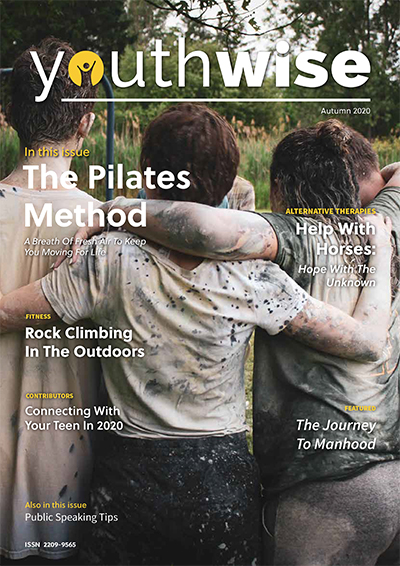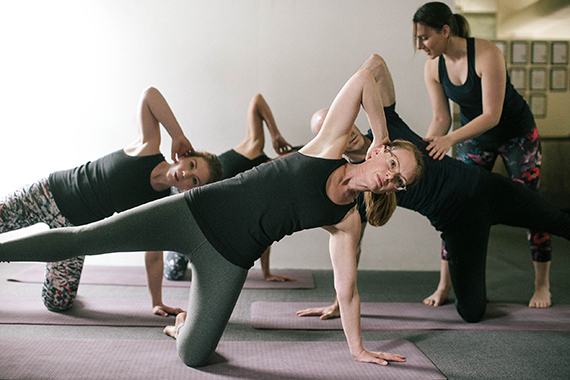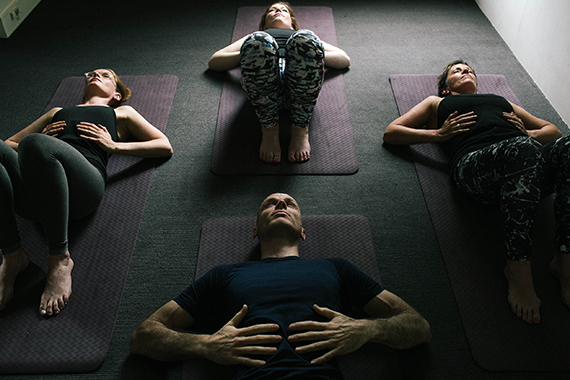
Link to: Youthwise magazine, Autumn issue 2020
Introduction
Our mission at Aligned for Life Pilates is to get the Pilates Method into the hearts and minds of as many people possible, so they too can experience the full benefits Pilates has to offer their mind, body and spirit.
This is an article written for the Youthwise Magazine, whose mission is to produce and distribute important information to young Australians affected by mental health issues and those affected directly or indirectly by substance abuse.
It may also benefit the wider community, with so many livelihoods being affected by the current pandemic, so please feel free to share, so you too can assist our mission.
Thanks!
Kath Banks
Aligned for Life Pilates – Moonee Ponds
Kath@alignedforlife.com.au
The Pilates Method – A breath of fresh air to keep you moving for life.
by PAA Member Kath Banks, Aligned for Life
‘Change happens through movement and movement heals.’ J. H. Pilates
Joseph Pilates was a man well ahead of his time, promoting the physical and mental benefits of exercise and creating a body conditioning system called ‘Contrology’. This involved a series of full body strengthening exercises, working each joint through its full range of movement with precision and control, focusing on a mind-body connection and the use of breath. It is what we now call the Pilates Method.
‘Contrology develops the body uniformly, corrects wrong posture, restores physical vitality, invigorates the mind, and elevates the spirit.’ J. H. Pilates
The benefits of exercise for mental health and well-being are well recognised with more and more people taking up ‘mindful’ exercises to assist with stress, anxiety and other mental health conditions. The benefits of exercise for mental health include improved memory and cognitive skills (thinking/focus), better sleep, development of coping strategies and resilience, distraction from negative thoughts and a sense of accomplishment.
‘The mind when housed in a healthful body possesses a glorious sense of power.’ J. H. Pilates
Beyond blue states exercise can be as effective as talking therapy and medication for treating mild-moderate depression. The Black Dog Institute reveals, just 1 hr of exercise per week, of any intensity can deliver significant protection against depression. The World Health Organisation recommends up to 150 mins per week of moderate physical activity for increased mental and physical health benefits. Unfortunately 150 mins may sound like an impossible task for those suffering a mental health condition, where just getting out of bed can seem hard enough.
This is where mindful exercise and starting with the basics, can be the first step to getting back on track to both physical and mental well-being. One benefit of the Pilates Method, is that movement can be broken down into its most simple and achievable form, then progressively built up to provide an intense physical workout. This allows almost everybody, the ability to participate in the Pilates Method in one form or another, and to use it to get movement and exercise back in their life.
‘Every moment of our life can be the beginning of great things.’ J.H. Pilates
Many of us who practise the Pilates Method, work with a set of guiding principles. Through the analysis and understanding of these principles, it becomes even more evident as to why the Pilates Method can assist those with mental health issues, get moving for life. These guiding principles include Breath, Centring, Concentration, Control, Precision, Flow, Alignment and Commitment.
Breath
We certainly can’t live without it and through an increased focus we can gain even more benefits. The Pilates Method utilises various breathing techniques dependent upon the desired effect. Breath can be used in a calming manner to de-stress or used to invigorate and energise the body.
Stress and anxiety can lead to a build-up of tension in the muscles, as well as a stress hormone, cortisol. Over time, high cortisol levels can have a negative impact on the body causing, weight gain, high blood pressure, disrupted sleep, reduced energy levels and a negative impact on mood. Deep breathing has a positive impact on cortisol levels, as well as assisting to relax the muscles and the mind. This is where most Pilates classes start, but they will then build in intensity and breath, both inhale and exhale, will be utilised to complement each exercise and maintain a sense of focused movement.
‘Before any real benefit can be derived from physical activity, first one must learn how to breathe properly. Our very life depends on it.’ J. H Pilates
Centring
Centring flows on from breath, providing a specific place to focus and direct your attention. Centring your mind provides an inner calm. Drawing your attention away from the peripheral world and any negativity associated with it and redirecting it to the centre of your body. When physically centred, there is an equal balance of all muscles, working evenly with one another, providing a stable ‘core’ for movement without unnecessary tension and bracing. Centring your joints in their most optimal position creates freedom of movement, allowing you to move without unnecessary tension.
Concentration
Centring requires concentration, as does consciously focusing on your moving body when performing Pilates and other exercises. This focused concentration on movement allows the stress of the day to be left far behind. Concentration provides a distraction from any negative thoughts that may have been lingering. During your 10, 20, or 60 mins of Pilates, your mind and body can be free of stress, creating a better mindset to deal with the rest of your day. Joe Pilates kept the repetitions of each exercise to a minimum – only as many as the mind could stay focused on the exercise.
Control
There may be many aspects of your life that you don’t feel in control of, so use the Pilates Method to take control of your body and therefore your mind. Take control of how your body moves and therefor how it feels, and your mind is the conductor. You must be in full control of your whole body when executing each exercise with Precision.
Precision
Precision doesn’t mean perfection! It’s something to work towards and allows the body to become more proficient at each exercise. With proficiency, comes self-mastery and a deep sense of accomplishment. This builds self-esteem and self-worth and drives us to continually challenge ourselves even further. Success drives more success and success makes us feel good. Once precision and motor control are accomplished, the body doesn’t forget and so Pilates becomes a place of familiarity, a safe & happy place to visit when life throws up its challenges. All you need is a space to lie down – no equipment necessary.
Flow
Flowing movement is often what our muscles and our joints crave. Motion is the lotion to free our muscles and joints from unwanted tension. Many clients describe themselves as feeling lighter and floating after a Pilates class, like a weight has shifted off their shoulders. Flowing from one exercise to the next to the next, also provides a mindful distraction. There is no time to think about any negative thoughts, as your mind is focused on what exercise is coming next and how to get from one position to the next, seamlessly. This when you truly experience the pure joy of movement.
Alignment
Several studies have suggested poor posture may exacerbate the symptoms of clinical depression and anxiety. Patients with mild to moderate depression felt more alert by keeping their back and shoulders upright while sitting and reported less anxiety (Wilkes et al., 2017), however slouched walking increased depression and decreased energy levels (Peper & Lin, 2012). This indicates the mind-body relationship is a two-way street and maintaining an upright posture can be a simple way to boost self-esteem. Good posture is also associated with better body image among people with depression (Canales et al., 2014).
The Pilates Method continuously works on the alignment of all joints to create a more optimal posture. There is a constant focus on balancing strength and mobility so we can sit, stand and move with ease and efficiency, combating the downward drag of gravity and the stresses of life. Through thoughtful movement we improve our body awareness, so we can self-correct when we are not in our most optimal body position. Lift your back & shoulders, to lift your mood.
Commitment
Commitment is key to making a difference in your life. Start small and slowly build. What is achievable for you today? Perhaps just 3-5 mins of focused breathing to start (see Exercise – Progressive Balloon Breathing). Try adding 1-2 new exercises or 3-5 mins extra to your practise, each week – it’s up to you. But make a commitment to practise each week, decide how many days you can manage and how many minutes or how many exercises. Make a commitment to YOURSELF and the practise of movement, to build a positive relationship between your mind, body and your spirit.
Our mission is to get the Pilates Method into the hearts and minds of as many people possible, so they too can experience the full benefits it has to offer their mind, body and spirit.
Exercise – Progressive Balloon Breathing
Set up – lying on your back, knees bent, feet on the floor or up on a bench/chair, hands on your stomach
Activity – Gently breath in through your nose and count how long your breath lasts. Gently breath out and make it last the same number of counts
On your next breath, try to make your breath in last 1 more count and your breath out last 1 more count. Continue to add 1 more count to each breath in and breath out. Repeat for 6-10 breaths
So 1st breath lasts 5 slow counts, the next 6 counts, the next 7 counts and so on………..
Imagine – your whole torso is a balloon. As you breath air in, you fill up like a balloon. As you breath air out, your torso deflates, just like a balloon. Each breath in stretches the balloon a little more and each breath out empties and deflates the balloon a little more – but with complete control and without developing tension anywhere. Continue to be gently with your breath.
Goals – relaxation, tension release, distraction, activation of deep postural muscles, improved breathing mechanics
References
Wilkes, C., Kydd, R., Sagar, M. and Broadbent, E. (2017) Upright posture improves affect and fatigue in people with depressive symptoms. J. Behav. Ther. Exp. Psychiatry. 54:143-149.
Peper, E. and I-Mei Lin (2012) Increase or Decrease Depression: How Body Postures Influence Your Energy Level. Biofeedback. 40 (3):125-130.
Canales, J., Cordas, T., Fiquer, J., Cavalcante, A. and Moreno, R. (2014) Posture and body image in individuals with major depressive disorder: a controlled study. DOI: 10.1590/S1516-44462010000400010 · Source: PubMed



Comments are closed.